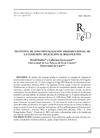Please use this identifier to cite or link to this item:
https://accedacris.ulpgc.es/jspui/handle/10553/7753
| Title: | Tentativa de conceptualización tridimensional de la cohesión: aplicación al baloncesto | Other Titles: | An attempt at a three-dimensional conceptualization of cohesion: application to basketball | Authors: | Maltête, David Garncarzyk, Catherine |
UNESCO Clasification: | 61 Psicología 241106 Fisiología del ejercicio |
Keywords: | Cohesión Sociometría Complejidad Cohesion Sociometry, et al |
Issue Date: | 2006 | Journal: | Revista Iberoamericana de Psicologia del Ejercicio y el Deporte | Abstract: | El objetivo del presente estudio es considerar el concepto de cohesión de manera tridimensional. La muestra está formada por cuatro equipos de baloncesto de 48 jugadores, los cuales tienen entre 18 y 37 años y juegan en la Liga EBA (España). Se administró el cuestionario sociométrico (Moreno, 1934) a los jugadores de cada equipo al final del campeonato. Paralelamente, se observó a los equipos en situación de competición (partido oficial), de entrenamiento, y además, el escrutinio de los resultados dió lugar a entrevistas con cada uno de los entrenadores. Los resultados encontrados confirman que unos niveles elevados de rendimiento coinciden con unos índices de cohesión elevados. Se evidenció que (1) el aspecto jerárquico de la cohesión es una dimensión intrínseca (Cota et al., 1995; Dion, 2000); (2) las tres dimensiones constitutivas de la cohesión presentan zonas comunes (funcional/social; social/jerárquico; jerárquico/funcional; funcional/social/jerárquico), y (3) una forma de medir el nivel de cohesión a partir del análisis sociométrico. Se sugiere a partir del presente trabajo que en futuros estudios se tenga en cuenta el cruce de los siguientes instrumentos: el “Group Environnement Questionnaire” (Carron, Widmeyer y Brawley, 1985), el paradigma sociométrico (Moreno, 1954) y el “Scale Categorization Theory” (Turner et al., 1987) con vistas a relacionarlos entre sí, de manera que nos permita comprender mejor los fenómenos grupales. The main objective of the research was to assimilate the concept of cohesion in a three-dimensional way. It was conducted over 48 basketball players, ages ranging from 18 to 37, from four basketball teams participating in E.B.A League (Spain). The sociometric questionnaire (Moreno, 1934) was filled in by players from each team at the end of championship. At the same time, teams were observed in official game and practice situation. Besides, test results check out was followed by a meeting with each coach. The present findings confirm that high performance levels coincide with high cohesion rates. We made obvious that (1) hierarchical aspect is an intrinsic to cohesion (Cota et al., 1995; Dion, 2000); (2) there are congruent areas for the three dimensions which constitute cohesion (functional / social; social / hierarchical; hierarchical / functional; functional / social / hierarchical); and (3) given this construct, a way measuring cohesion level for each one of the teams. We suggest future researches, taking into consideration the converge of the following points of view: the "Group Environnement Questionnaire" (Carron, Widmeyer and Brawley, 1985), Sociometric paradigm (Moreno, 1954) and "Scale Categorization Theory" (Turner et al., 1987); with the intention of coordinating them so that we can understand groups phenomena in a wider way. |
URI: | https://accedacris.ulpgc.es/handle/10553/7753 | ISSN: | 1886-8576 | Source: | Revista Iberoamericana de Psicologia del Ejercicio y el Deporte [ISSN 1886-8576], v. 1 (1), p. 95-112, (2006) |
| Appears in Collections: | Rev. Iberoam. psicol. ejerc. deporte. 2006. v.1, n.1 Artículos |
WEB OF SCIENCETM
Citations
1
checked on Feb 25, 2024
Page view(s)
48
checked on Sep 16, 2023
Download(s)
22
checked on Sep 16, 2023
Google ScholarTM
Check
Share
Export metadata
Items in accedaCRIS are protected by copyright, with all rights reserved, unless otherwise indicated.
